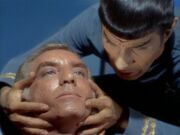
Spock performing a Vulcan mind meld.

Through a mind meld, T'Laan saw the last treasured memories of Romulan Ambassador Joltair shortly after his death.
The Vulcan mind meld (or mind touch) is a telepathic technique employed exclusively by Vulcans, in which the minds of two individuals become a single entity. In the Vulcan language, it was known as taroon-ifla. (TOS episode: "Dagger of the Mind"; Last Unicorn RPG module: The Way of Kolinahr: The Vulcans)
Overview[]
Typically, physical contact was required for a mind meld. However, particularly powerful melders, such as Spock or Slovaak, are capable of performing melds remotely. (ST video game: Away Team; TOS episodes: "A Taste of Armageddon", "By Any Other Name", "The Omega Glory")
As Vulcans were touch telepaths, they normally conducted a mind meld by touching the bioelectrical focal points on the face. These focal points were known as the "qui'lari" in the Vulcan language.[1][2] Vulcan poets referred to these points as being portals to the mind.[3]
Melding was a deeply personal experience, as the two minds of the meldees were entirely open to each other.[4][5] Every mind meld left a trace signature, due to a subtle alteration of the neural synapses and pathways. Furthermore, Vulcans developed a code where one did not initiate mind-melds without the consent of the other party and they never entered the mind of another without permission.[6]
Melding can be used as an interrogation technique by the melder blocking access to their mind. Those that learned this discipline on Vulcan were required to take an oath that they would rather die before violating the privacy of another's consciousness against their will. (TOS novel: Mindshadow)
Melding can be dangerous, particularly so when conducted with a non-Vulcan, but it can also be a useful tool; some neurological conditions can be cured by a mind meld.[7] A Vulcan dying from the severing of the marriage bond can be saved through a healing mind meld initiated by close friends or family.[8]
Mind melds often result in part of each of the participant’s knowledge and mental state being transferred to each other. They can also be used to deposit or obtain a katra from the other participant. (TOS movie: Star Trek II: The Wrath of Khan)
Memories from generations of Vulcans were capable of being passed down to their descendants, which meant that melding was partly responsible for the retention of ancient Vulcan traditions. (TOS novel: Captain's Glory)
Surak's teachings on the sanctity of an individual governed much of Vulcan mind meld rules. As such, except in cases of mutual consent, Vulcans rarely mind melded, with exceptions for those suffering from mental illness. The Federation, under their agreement with the Vulcans, allowed the use of mind-melds to read the thoughts of alien races. (TOS novel: Crisis on Vulcan)
History[]

Tolaris and T'Pol in a mind meld. (Fusion)
The practice of melding dated at the least back to the time of Surak. Around the turn of the 20th century, Romulan sleeper agents managed to have falsified medical studies published suggesting that mind melding was neurologically and psychologically harmful. The agents' goal was to manipulate Vulcan society to reject the use of mind melds, in order to nullify the telepathic advantage the Vulcans held over their Romulan cousins. (ENT - Rise of the Federation novel: Uncertain Logic)
By the mid-22nd century, a stigma had developed around melding. Those who were capable of or practiced melding were seen as an undesirable minority. As a consequence, Pa'nar Syndrome, a neurological condition contracted by inexperienced mind melders, also became a taboo subject. Ironically, Pa'nar Syndrome can easily be cured by a meld with an experienced melder. Following reforms on Vulcan in 2154, melding once again became socially acceptable. (ENT episodes: "Fusion", "Stigma", "Kir'Shara")
Whilst the minority group of melders were now socially acceptable, the earlier generations of Vulcans felt that the openness of their telepathic procedures was uncouth or perverted. This was because the non-melders had been raised to believe that a limited mind-touch was acceptable only in the case of establishing the mating bond. These older Vulcans felt that melding risked compromising the identity, privacy, and mental balance of the individual. This pattern of thinking still existed with some older Vulcans in the mid-23rd century. (ENT - Rise of the Federation novel: Uncertain Logic; TOS novel: Ex Machina)
In 2248, a Marathan rebel by the name of Wurnall assaulted Amanda Grayson at the Sarek estate. This led to Sarek petitioning the House of Justice to conduct a mind meld on the Marathan to discover his reasoning. Performing a mind meld was a problem, as Maratha was not a Federation world. Thus, the trio of female Vulcan Justices had to decide on the legal issue but were reluctant to create a legal precedent on the matter. (TOS novel: Crisis on Vulcan)
By the mid-23rd century, evidence obtained through the use of mind melds was acceptable by the courts of the Federation. (TOS novel: The Patrian Transgression)
While mind melds generally did not work on mechanical lifeforms, when the USS Enterprise made first contact with the Cybertronian race, Spock speculated that, based on the similarity of their processors to the humanoid brain that a mind meld would work. He confirmed this by using the technique to rouse Optimus Prime from stasis lock. (TAS - Star Trek vs. Transformers comic: "Issue 2")
Among notable opponents to mind melds was Soreth, who found the practice distasteful in 2273. (TOS novel: Ex Machina)
Kelvin timeline[]
In 2263 of the Kelvin timeline, at the Babel Conference on Babel, Starfleet Cadet T'Laan was a able to use a mind meld with Romulan Ambassador Joltair's corpse to discover the real culprit behind his murder. (TOS - Boldly Go comic: "Issue 8")
Alternate realities[]
In the mirror universe, T'Pol used a mind meld to interrogate Charles Tucker regarding the prefix code of the ISS Nobunaga. T'Pol was also able to use a mind meld to plant a mental suggestion to make him sabotage the ISS Enterprise's cloaking device. (Mirror Universe short story: "Nobunaga"; ENT episode: "In a Mirror, Darkly")
In an alternate timeline where Montgomery Scott rescued James T. Kirk before he could be absorbed into the Nexus, Scott offered to allow Supreme Arbiter of the Alliance Sarek to mind meld with him. The purpose of the meld was to verify the officer's claims of coming from an alternate reality. Sarek refused, due to both the inherent danger in melding with a non-Vulcan and the suspicion that Kirk might be a spy for the Borg, which would reveal Alliance secrets to the hivemind. Kirk offered a meld as well, stating that since he had melded with Sarek in the primary universe, it might be easier for the two minds to join. Sarek pointed out he was not the same individual, and thus it was irrelevant. (ST novel: Engines of Destiny)
Appendices[]
References[]
- TOS episode: "Dagger of the Mind"
- TOS episode: "A Taste of Armageddon"
- TOS episode: "By Any Other Name"
- TOS episode: "The Omega Glory"
- TOS movie: Star Trek II: The Wrath of Khan
- TOS novel: The Vulcan Academy Murders
- TOS novel: Mindshadow
- TOS novel: The Patrian Transgression
- VOY episode: "Meld"
- DS9 episode: "The Muse"
- TOS novel: Crisis on Vulcan
- TOS novel: Assignment: Eternity
- Last Unicorn RPG module: The Way of Kolinahr: The Vulcans
- ST video game: Away Team
- ENT episode: "Fusion"
- ENT episode: "Stigma"
- ENT episode: "Kir'Shara"
- TOS novel: Ex Machina
- ST novel: Engines of Destiny
- ENT episode: "In a Mirror, Darkly"
- TOS novel: Burning Dreams
- TOS novel: Captain's Glory
- Mirror Universe short story: "Nobunaga"
- ENT - The Romulan War novel: Beneath the Raptor's Wing
- ENT - Rise of the Federation novel: Uncertain Logic
- TOS - Boldly Go comic: "Issue 8"
External links[]
- Mind meld article at Memory Alpha, the wiki for canon Star Trek.
